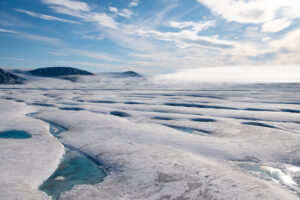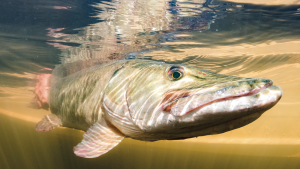
Environment
The truth about carbon capture
Carbon capture is big business, but its challenges fly in the face of the need to lower emissions. Can we square the circle on this technological Wild West?
- 5042 words
- 21 minutes
Environment
Research institutions from across Canada and the U.S. collaborate to collect and analyze carbon samples from the Great Lakes during peak ice coverage

In a first-of-its-kind campaign, researchers from Canada and the U.S. visited all five Great Lakes last week to analyze and collect carbon samples from the ice and water. The project, aptly named the Winter Grab, is a cross-border collaboration between Canadian universities — including Trent, Lakehead and Windsor — and U.S. research facilities. The aim: to observe water quality and life in and underneath the ice. The Winter Grab is spearheaded by Marguerite Xenopoulos, Canada Research Chair in Global Change of Freshwater Ecosystems and professor at Trent University.
The Winter Grab fills a research gap in a season often ignored by scientists studying and sampling the Great Lakes, with most researchers focusing on spring and summer sampling, according to Xenopoulos, an expert in dissolved organic carbon. “The urgency was that winter in the Great Lakes is rapidly changing because of climate change,” says Xenopoulos. The lack of knowledge around the rapid loss of ice in the Great Lakes — where 20 per cent of the world’s surface freshwater is held — provided Xenopoulos’ team with the impetus to explore why this is happening.
“There’s this belief that winter is mainly a time of dormancy with very little biological activity,” says Xenopoulos. “We now know that this is not true. Life under the ice, and in the ice, can be diverse.” The project was three years in the making and, with funding finally provided, the team started to officially plan the Winter Grab last year.

The project also provides unique opportunities for students. Nolan Pearce, also a professor at Trent University, was invited to help lead graduate students to provide assistance in the field.
“Some of the students are getting hands-on experience and samples that they don’t get with their own projects,” says Pearce. “Winter sampling is less common than more traditional limnological sampling. So, they’re getting to core holes through the ice with the auger, see how we take these kinds of underwater samples and just be out in an environment they don’t normally get to be in.”
Feb. 14 was chosen as the start date for the Winter Grab due to it being “the historical peak for ice cover for the Great Lakes,” according to Pearce. The project was estimated to take around a week to complete, with the time needed to gather the results and analyze each sample.
Some Winter Grab researchers are examining winter algae populations. Xenopoulos points out that the Great Lakes are potential hotspots for algal blooms. She adds that the amount of algae growth during winter could impact the likelihood of large summer blooms, such as the one that occurred in Lake Erie in 2014 and forced the shutdown of drinking water intake for the city of Toledo, Ohio. Algae consume excess phosphorus and nitrogen from agricultural runoff into their biomass, causing the algae to multiply in warm, calm summer waters, and then slowly release harmful toxins into the lake.
Xenopoulos is also keen to highlight the collaborative nature of the project. “The unique thing about this expedition is that it’s the first time there’s going to be a bunch of us there. We’re all collecting the samples in the same way at the same time. Then, everyone’s bringing in their expertise and measuring different components of the samples collected,” says Xenopoulos.
By studying samples from the Great Lakes, the Winter Grab can better help scientists better understand the effects of global warming on both the lakes and the planet as a whole.
Are you passionate about Canadian geography?
You can support Canadian Geographic in 3 ways:

Environment
Carbon capture is big business, but its challenges fly in the face of the need to lower emissions. Can we square the circle on this technological Wild West?

Environment
What the collapse of the Milne ice shelf and the loss of a rare Arctic ecosystem might teach us about a changing planet

Environment
In his new book, Klaus Dodds delves into the fascinating natural and cultural history of ice

Environment
How a cocktail of invasive species and global change is altering the Great Lakes-St. Lawrence River ecosystem